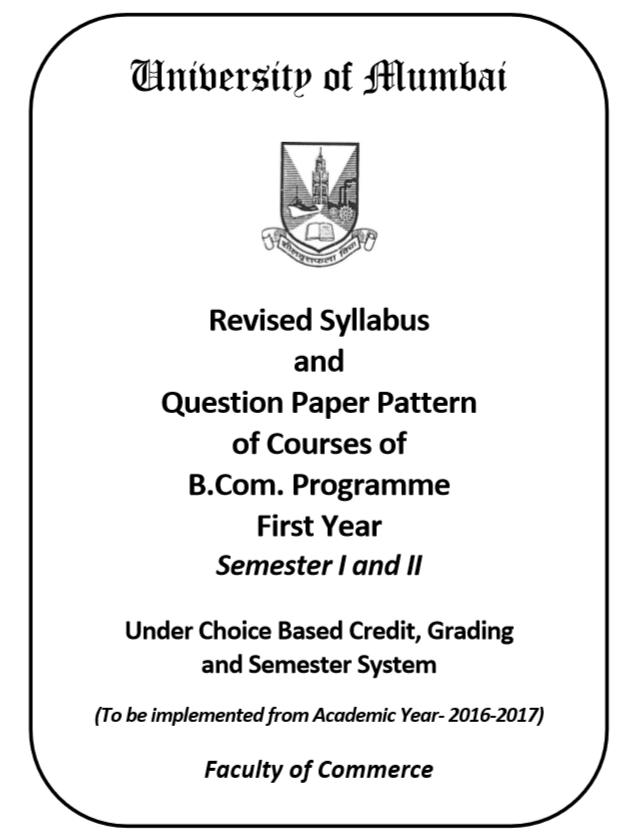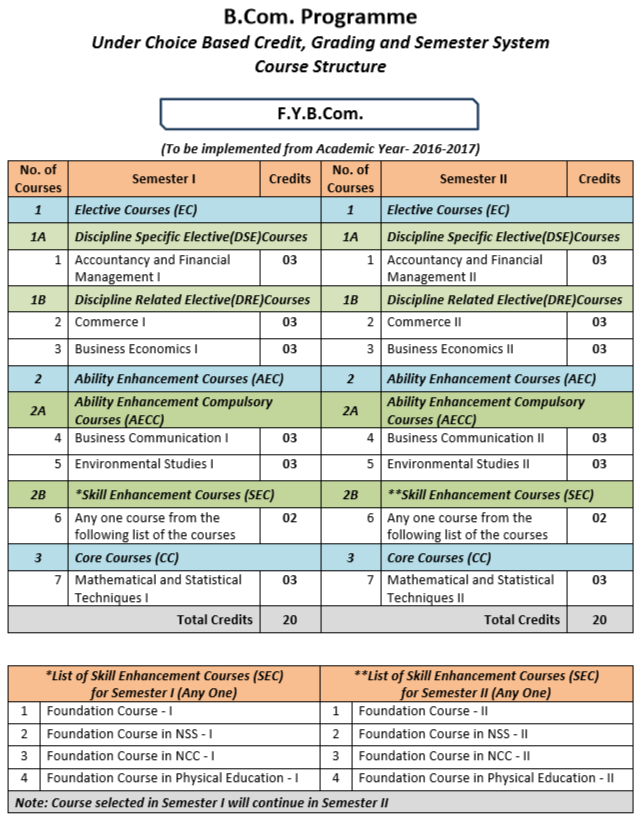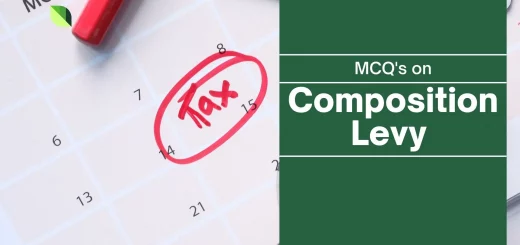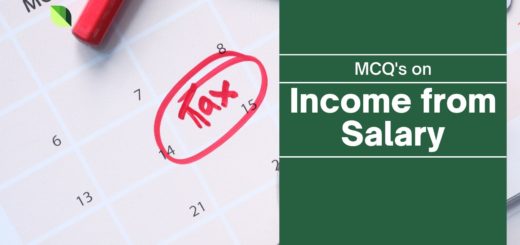FYBCOM Syllabus – Mumbai University 2022-23 | Download Free Pdf
Table of Contents
FYBCOM Syllabus Subject wise list of Sem I
1) Accountancy & Financial Management – I
Chapter 1: Accounting standards issued by ICAI and Inventory Valuation
- Accounting standards:
- Concepts,benefits,proceduresforissueofaccountingstandardsVariousAS :
- AS – 1: Disclosure of Accounting Policies
- Purpose, AreasofPolicies, DisclosureofPolicies, Disclosure of Change in Policies,
- Illustrations
- AS–2:Valuationof Inventories (Stock)
- Meaning, Definition, Applicability, Measurement of Inventory,
- DisclosureinFinalAccount, ExplanationwithIllustrations.
- AS – 9: Revenue Recognition
- MeaningandScope, Transactionsexcluded, Sale of Goods, Rendering of Services,
- EffectsofUncertainties, Disclosure, Illustrations.
- Inventory Valuation
- Meaning of inventories Cost for inventory valuation
- Inventory systems: Periodic Inventory system and Perpetual Inventory System
- Valuation: Meaning and importance
- Methods of Stock Valuation as per AS – 2 :
- FIFO and Weighted Average Method Computation of valuation of inventory as
- on balance sheet date: If an inventory is taken on a date after the balance sheet or
- before the balance sheet
FYBCOM Syllabus Textbooks Pdf Click Here
Chapter 2: Final Accounts
- Expenditure: Capital, Revenue
- Receipts: Capital, Revenue
- Adjustment and Closing Entries
- Final accounts of Manufacturing concerns (Proprietary Firm)
Chapter 3: Departmental Accounts
- Meaning
- Basis of Allocation of Expenses and Incomes/Receipts
- Inter-Departmental Transfer: at Cost Price and Invoice Price Stock Reserve
- Departmental Trading and Profit & Loss Account and Balance Sheet
Chapter 4: Accounting for Hire Purchase
- Meaning, Calculation of interest
- Accounting for hire purchase transactions by asset purchase method based on full
- cash price
- Journal entries, ledger accounts, and disclosure in the balance sheet for hirer and
- vendor(excluding default, repossession, and calculation of cash price)

2) Mathematical & Statistical – I
Chapter 1: Shares and Mutual Funds
• Shares: Concept of share, face value, market value, dividend, equity shares, preferential shares, bonus shares. Simple examples.
• Mutual Funds: Simple problems on the calculation of Net income after considering entry load, dividend, change in Net Asset Value (N.A.V.), and exit load. Averaging of price under the Systematic Investment Plan (S.I.P.)
Chapter 2: Permutation, Combination, and Linear Programming Problems
• Permutation and Combination: Factorial Notation, Fundamental principle of counting, Permutation as arrangement, Simple examples, combination as selection, Simple examples, Relation between nCr and nPr
Examples of the commercial application of permutation and combination, Summarization Measuresar equation Ax +By + C= 0 (ii) linear inequalities. Mathematical Formulation of Linear Programming Problems up to 3 variables. Solution of Linear Programming Problems using graphical method up to two variables.
Chapter 3: Summarization Measures
• Measures of Central Tendencies: Definition of Average, Types of Averages: Arithmetic Mean, Median, and Mode for the group as well as ungrouped data. Quartiles, Deciles and Percentiles. Using Ogive locate median and Quartiles. Using Histogram locate mode. Combined and Weighted mean.
• Measures of Dispersions: Concept and idea of dispersion. Various measures Range, Quartile Deviation, Mean Deviation, Standard Deviation, Variance, Combined Variance.
Chapter 4: Elementary Probability Theory
• Probability Theory: Concept of random experiment/trial and possible outcomes; Sample Space and Discrete Sample Space; Events their types, Algebra of Events, Mutually Exclusive and Exhaustive Events, Complimentary
events.The classical definition of Probability, Addition theorem (without proof), conditional probability.Independence of Events: P( A∩B ) = P(A) P(B). Simple examples.
• Random Variable: Probability distribution of a discrete random variable; Expectation and Variance of random variable, simple examples on probability distributions.
Chapter 5: Decision Theory
Decision-making situation, Decision maker, Courses of Action, States of Nature, Pay-off and Pay-off matrix; Decision making under uncertainty, Maximin, Maximax, Minimax regret, and Laplace criteria; simple examples to find an optimum decision. Formulation of Payoff Matrix. Decision making under Risk, Expected Monetary Value (EMV); Decision Tree; Simple Examples based on EMV. Expected Opportunity Loss (EOL), simple examples based on EOL.
3) Environmental Studies-I
Chapter 1: Solid Waste Management for Sustainable Society
Classification of solid wastes – Types and Sources of Solid Waste; Effects of Solid Waste Pollution- Health hazards, Environmental Impacts; Solid Waste Management – Solid waste management in Mumbai- Schemes and initiatives run by MCGM – the role of citizens in waste management in Mumbai.
Chapter 2: Agriculture and Industrial Development
Environmental Problems Associated with Agriculture: Loss of Productivity, Land Degradation, desertification Uneven Food Production – Hunger, Malnutrition and Food Security – Sustainable Agricultural practices
Environmental Problems Associated with Industries – pollution -Global warming, Ozone Layer Depletion, Acid rain, – Sustainable Industrial practices – Green Business and Green Consumerism, Corporate Social Responsibility
Chapter 3: Tourism and Environment
Tourism: Meaning, Nature, Scope and importance –Typology of tourism- classification; Tourism potentials in India and challenges before India; New Tourism Policy of India; Consequences of tourism: Positive and Negative Impacts on Economy, Culture and environment- Ecotourism
Chapter 4: Environmental Movements and Management
Environmental movements in India: Save Narmada Movement, Chipko Movement, Appiko Movement, Save Western Ghat and Save Jaitapur; Environmental Management: Concept, need and relevance; Concept of ISO 14000 and 16000; Concept of Carbon Bank and Carbon Credit.EIA – Environment Protection Acts – Concept and components of Geospatial Technology- Applications of GST in Environmental Management.
Chapter 5: Map Filling
Map filling of Konkan and Mumbai (Environmentally significant features and GST centers) using point, line and polygon segment. Concept and Calculation of Environmental Performance Index (EPI)
4) Commerce – I
Chapter 1: Business
Introduction: Concept, Functions, Scope, and significance of business. Traditional and Modern Concept of business.
Objectives of Business: Steps in setting business objectives, classification of business objectives, Reconciliation of Economic and Social Objectives.
New Trends in Business: Impact of Liberalization, Privatization and Globalization, Strategy alternatives in the changing scenario, Restructuring and turnaround strategies
Chapter 2: Business Environment
Introduction: Concept and Importance of business environment, Inter- relationship between Business and Environment
Constituents of Business Environment: Internal and External Environment, Educational Environment and its impact, International Environment – Current Trends in the World, International Trading Environment – WTO and Trading Blocs and their impact on Indian Business.
Chapter 3: Project Planning
Introduction: Business Planning Process; Concept and importance of Project Planning; Project Report; feasibility Study types and their importance
Business Unit Promotion: Concept and Stages of Business Unit Promotion, Location – Factors determining location, and Role of Government in Promotion.
Statutory Requirements in Promoting Business Unit: Licensing and Registration procedure, Filling returns and other documents, Other important legal provisions
Chapter 4: Entrepreneurship
Introduction: Concept and importance of entrepreneurship, factors contributing to Growth of entrepreneurship, Entrepreneur and Manager, Entrepreneur and Intrapreneur
The Entrepreneurs: Types of Entrepreneurs, Competencies of an Entrepreneur, Entrepreneurship Training and development centers in India.Incentives to Entrepreneurs in India. Women Entrepreneurs: Problems and Promotion.
5) Business Economics – I
- Business Communication – I
- Foundation Course – I
FYBCOM Syllabus Subject wise list of Sem II
- Accountancy & Financial Management – II
- Mathematical & Statistical – II
- Environmental Studies-II
- Commerce – II
- Business Economics – II
- Foundation Course – II


You can download FYBCOM Syllabus from the below link


